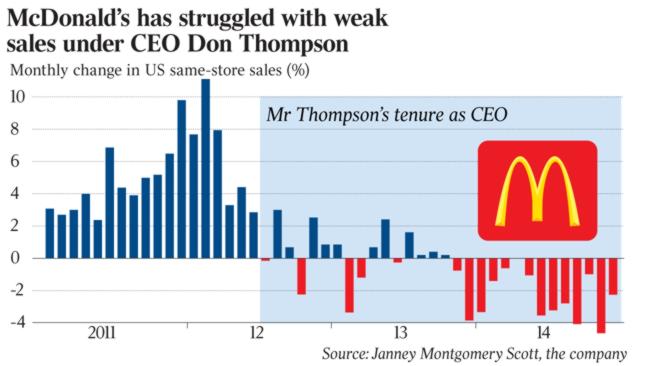McDonald’s sales are so bad they just stopped sharing the numbers
Since its first restaurant opened in San Bernardino, California, in 1940, McDonald's is the standard bearer of "Americana." The first and last word in fast food, McDonald's offers the ultimate in convenience dining globally for 60 years. The McDonald Brothers turned a simple burger joint into an instantly recognizable corporate entity that operates in over 36,500 restaurants, 119 countries and feeds 68 million people daily. More than 3/4 of a century after its inception, fervor is waning with the "I'm Lovin' It," ethos of the fast food franchise. So now, the innocuous sweetness of mascot, Ronald McDonald, has evolved into a Creepy Clown, whose tricks now foster concerns about fast food's detriment to health. Add increased knowledge of what goes on our plates and worries over genetically modified crops, the Big Mac's appeal is now going the way of a rancid slice of gherkin. The corporation has been on the ascendency since Ray Kroc opened his Des Plaines, Illinois franchise in 1955. Recent financial reports have not been such a tasty morsel for the food giant, however. As of April last year, McDonald's suffered its 11th consecutive month drop in same-store sales with overall sales in America dipping by 4% and 1.7% worldwide. The ignominy of parading such losses forced the restaurant chain to renege on reporting monthly sales figures, which it began in 2003. The embarrassing numbers have forced McDonald's to make concessions, such as remodeling into: "a modern, progressive restaurant."
Some of their measures like increasing wages, adding all-day breakfasts, granting greater power to franchisees and customized burgers, may go some way towards Hamburgling some losses back. Although McDonald's is far from being ruined and Ronald McDonald is a long way from lurking in the woods like his Creepy Clown peers, do the losses indicate a culinary paradigm shift? There could be numerous reasons behind their drop, one of the most straightforward explanations would be a spike in greater and varied competition. For example, in the UK, chicken restaurant Nando's has exploded in popularity, offering swift peri-peri chicken on a plate. Another excuse could be the economic struggles of the last several years. Although McDonald's isn't particularly expensive, it is an indulgence that people avoid when penny-pinching. Frugality has prompted a rise in money conscious cooks, who take aim at taste and price in equal mouthwatering measures. Bloggers like Jack Monroe have made menus on a shoestring almost de rigeur when financially troubled waters are choppier than ever. Also, apps and sites like Tasty make kitchen innovation simplistic in our social media saturated epoch. With their fast and quirky videos with equally quirky alterations to contemporary favorites, sites like Buzzfeed's Tasty delivers something different to cooking without the tedium of lessons.

GMO scandals inspire people to know what's in their food more than ever. GMOs are a double-edged sword, in some ways, engineering crops to withstand extremes in climate may aid global poverty. However, with GMOs and advances like CRISPR Gene Editing, there are limitless possibilities to mutating plants with some very questionable variants... glow in the dark pigs, anyone? Quick "Frankenfood" concoctions in a lab could become cheaper than fresh, organic materials and corporations are all about minimizing spending to maximize profit. Fast food has never been a benchmark of healthy eating - despite probing documentaries like Supersize Me forcing a rethink of McDonald's menus. So it may be all too tempting for McDonald's and other fast-food giants to become testing grounds for GMOs.

If you like my writing, then please consider donating to my Patreon. Thanks in advance!
Patreon: https://www.patreon.com/bradjames